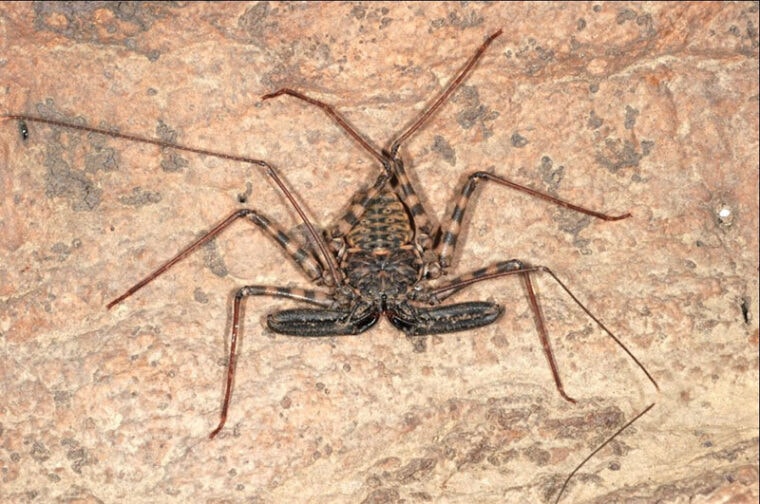
The Tanzanian Tailless Whip Scorpion is one of the freakiest looking yet coolest pets that you could add to your collection! If you’ve ever watched the Harry Potter movies, you might recognize it from Harry Potter and the Goblet of Fire as the “spider” that is hit with the “killing curse.”
But does the Tailless Whip Scorpion make a good pet? Yes! These creatures are completely harmless and are gentle enough even for beginners.
Read on if you’re interested in learning more about these fascinating arthropods!
What Exactly Is the Tailless Whip Scorpion?
Are they a scorpion or a spider? They look like a cross between a crab and a spider, and given that they’re arthropods, that’s no surprise.
Arthropods are a phylum of animals with an exoskeleton (essentially, their skeleton is on the outside of their bodies), jointed limbs, and segmented bodies and include crabs, lobsters, insects, scorpions, and spiders. So, spiders, scorpions, and Tailless Whip Scorpions are arachnids.
Tailless Whip Scorpions are more specifically known as Amblypygids, and they might look a little like a spider and somewhat like a scorpion but are actually neither. That said, they have been known as whip scorpions and whip spiders. They should not be confused with the Giant Whip Scorpion (also known as the vinegarroon), which can be found in parts of the United States.

The Many Names of the Tailless Whip Scorpion
These creatures have several names. They are known as the Tanzanian Giant Tailless Whip Scorpion, the Giant Tailless Whipscorpion, Whip Spider, and the African Whip Spider.
There are also 158 species of the Tailless Whip Scorpion. Fossilized remains have also been discovered, and they possibly go back as far as 385 million years!
The Habitat of the Tailless Whip Scorpion
The Tailless Whip Scorpion comes from Tanzania and Kenya. They typically live together in large numbers near ponds, under flat stones, in rocky cattle pastures, and sometimes caves, as well as under leaves and bark. They are primarily nocturnal, and they prefer the security of tight spaces.
How Does the Tailless Whip Scorpion Look?
These arthropods are among the largest of the Tailless Whip Scorpions. When they extend their legs, they can be 8 inches across (including leg span). The abdomen and carapace are flat, and they have eight long legs.
Their pedipalps at the front of their bodies look similar to claws, which are used to ensnare and crush their prey. Their front legs are long and whip-like in appearance and are used as sensors for sensing the environment, which is usually dark, and for vibrations that help them locate prey.
How large they get and their coloring depends on the species.
What Do They Eat?
The Tailless Whip Scorpion eats insects and can be fed crickets and other large insects — cockroaches (Dubia roaches in particular), grasshoppers, and flies are all options. You can give them several small crickets in the evenings (they are nocturnal and do their hunting at night) just once or twice a week.
While the Tailless Whip Scorpion prefers to drink water droplets, you should also keep a small dish with clean water available at all times.
Setting Up the Enclosure
The habitat should be glass and set up vertically, which is rather unusual, given that most terrariums are horizontal. If you’re planning on just getting one Tailless Whip Scorpion, the tank needs to be a 10-gallon one, but for two or a small group, you need to aim for 29 gallons.
You’ll also want to add cork bark. A nice large piece or two can be leaned against the tank, which will give the Tailless Whip Scorpion a nice shady place to hide. Be careful about the stability of these pieces of cork bark, though, as you don’t want them falling over and killing your pet.

How About the Substrate?
You should have a substrate of about 2 to 6 inches. It can be peat mixed with damp sand, or you can use coconut bedding or even organic peat.
On top of the substrate, you should add extra bark, cypress mulch, and dried leaves for additional areas that your Tailless Whip Scorpion can burrow into. Live plants can make for an attractive-looking habitat and add extra humidity and more hiding places.
What’s the Right Humidity and Temperature?
The temperature should sit at about 75°F to 85°F, and you might need to use a heat source to maintain this.
Humidity is critical! It should sit at 65% to 75%, but closer to 75% is best. You’ll need to spray the enclosure down at least two times a week or as often as it takes to keep the substrate damp, which will give you the right humidity levels.
Most Tailless Whip Scorpions will drink the water droplets that form on the glass of the tank.
What’s the Best Way to Handle Them?
It’s best not to handle them too often. Even though they have an exoskeleton, they are fairly delicate. They are fast too, so when you try to pick them up, you risk dropping them. Since they are quite docile and not prone to being aggressive, they choose to run and hide instead of attack. However, if they feel threatened, they might pinch with their little claws, but this will just feel like a tiny prick.

Females vs. Males
It’s a little easier to tell female Tanzanian Tailless Whip Scorpions apart from the males compared to other species. Males have much longer pedipalps than females, and the females might appear to be slightly larger.
These scorpions can live anywhere from 5 to 15 years with proper care, and the females are known to live longer than the males.
Then They Molt
The Tailless Whip Scorpion will molt several times throughout their lives. When your pet changes color and is green, blue, or white and appears to be plumper than usual, they are about to molt, and you need to stop feeding them. The high humidity levels will also help the molting process.
If you have more than one Tailless Whip Scorpion, you’ll also need to increase the feedings of the others. Molting leaves the scorpion in a weakened condition and vulnerable to cannibalism. You can also move them to another container until the molting has completed and your pet is back to their former self.
Where Can I Get One?
Unfortunately, the Tanzanian Tailless Whip Scorpion isn’t commonly found as a pet, but you might find one through online stores. You can also ask around through social media, including message boards, where you can speak to current Whip Scorpion owners.
They range in price from $20 to $50. Just double-check that the pet store is a good one that knows how to properly care for these arthropods, or look around for a breeder. These arachnids take to breeding quite well, and you might be able to find a young one from a breeder who has excellent knowledge of their history.
Conclusion
It’s amazing that such a creepy-looking arthropod could be such an amazing pet! Although many Tailless Whip Scorpion owners think that they’re pretty cute!
We hope that we’ve given you good and interesting information regarding these fantastic and unique little pets. If you decide to bring a Whip Scorpion home, there’s no doubt that you’ll have an attention-grabbing and intriguing new pet.
Featured Image Credit: Damon_diadema_003_L.D (Image Credit: Acrocynus, Wikimedia Commons CC SA 3.0 Unported)










